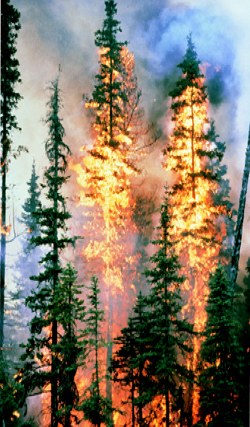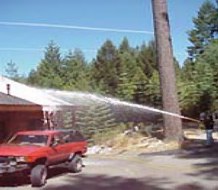Home Fire Technologies | home
FAQ
Are You FireSafe ?
Will you be prepared
when a wildfire threatens your
home and family?
 Not only is your home a valuable asset, it can provide a safe refuge during the passage of a wildfire. If you live in a rural area and are threatened by a fire, one of the safest places for you and your family may be your home, BUT ONLY IF YOU ARE PREPARED!
Not only is your home a valuable asset, it can provide a safe refuge during the passage of a wildfire. If you live in a rural area and are threatened by a fire, one of the safest places for you and your family may be your home, BUT ONLY IF YOU ARE PREPARED!Lives and property can be saved if you take a few simple precautions...
1. PLAN AHEAD EARLY
Don't wait until the fire season has started. Precautions should be taken before summer to help save your home, even if fire comes while you are away. A well prepared home has a better chance of being saved than an unprepared one.
By doing some simple cleanup and adding a foaming kit to each of your garden hoses, you will have the beginnings of a basic plan of defense.
|
 |
2. CLEAN UP AROUND YOUR HOME AND PROPERTY
Fires are spread and fuelled by flammable grasses, weeds, trees and bushes.
3. SPARK PROOF YOUR HOME
Most houses lost in wildfires have caught fire ON THE INSIDE, caused by burning debris or sparks blown through uncovered openings - windows, doors, eaves, the roof space or under the house. This is a very important point. Your home - and your family - have a much better chance of surviving a bushfire if the house is spark proof.
4. SET UP A WATER SUPPLY AND DELIVERY SYTEM
It is essential to make provision for an adequate water supply for firefighting. You cannot rely on public water mains or electricity during a wildfire. Your water supply and delivery system should be totally independent of utilities which, in the event of an emergency, may be inadequate or non-existent. (Remember the Oakland Hills fire in the SF Bay Area?)
Tanks, dams and swimming pools can provide necessary reserves provided you have the proper pump and enough hose to reach all areas to be protected. Ideally the system should provide coverage to the entire house as well as the defensible space around it.
Your water supply and delivery system should also be clearly labeled and designed to provide easy access for your local fire agency.
Also, be sure to test your equipment at least annually to ensure proper operation and to account for all supplies. Gasoline engines need their oil and gas replaced no less than once a season.
The NFPA has a formula for calculating the amount of water required to protect a specific structure. (Ref: NFPA 1142, Standard on Water Supplies for Suburban and Rural Fire Fighting, 1999 Edition)
5. ADD FOAM CAPABILITY TO YOUR DELIVERY SYSTEM
Foam concentrates can increase the coverage of a limited water supply up to 5 times! Foam breaks down the waters surface tension thereby improving waters penetration into porous surfaces and slowing its evaporation. In addition, the bubbles created act as an insulating barrier and help reflect infrared heat away from protected surfaces. When applied to the defensible space around your home, foam can increase waters effectiveness 5x or more!
We offer a variety of foaming kits allowing the addition offoam to everything from a standard garden hose to portable pumps or whole house hydrant systems.
|
 |
NOTE: The information contained on this page has been compiled from a variety of sources. No guarantee is made as to the accuracy of any of the information and the views expressed are offered only as general information. Information contained on linked pages are those of the respective authors and are not necessarily the opinions of Home Fire Technologies, it's employees or dealers.
Have questions?
(208) 659-0523 or [email protected]